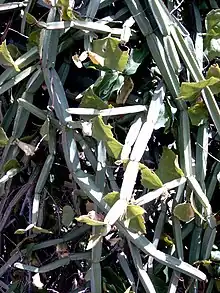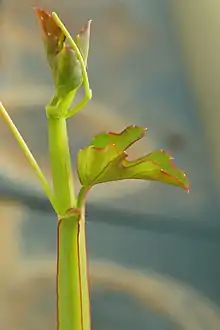| Cissus quadrangularis | |
|---|---|
 | |
| Scientific classification | |
| Kingdom: | Plantae |
| Clade: | Tracheophytes |
| Clade: | Angiosperms |
| Clade: | Eudicots |
| Clade: | Rosids |
| Order: | Vitales |
| Family: | Vitaceae |
| Genus: | Cissus |
| Species: | C. quadrangularis |
| Binomial name | |
| Cissus quadrangularis | |
| Synonyms[1] | |
| |


Cissus quadrangularis is a perennial plant of the grape family. It is commonly known as veldt grape, winged treebine[2] or adamant creeper.[3] The species is native to tropical Asia, the Arabian Peninsula and much of Africa.[2]
Description
Cissus quadrangularis reaches a height of 1.5 m (4.9 ft) and has quadrangular-sectioned branches with internodes 8–10 cm (3–4 in) long and 1.2–1.5 cm (0.5–0.6 in) wide. Along each angle is a leathery edge. Toothed trilobe leaves 2–5 cm (0.8–2.0 in) wide appear at the nodes. Each has a tendril emerging from the opposite side of the node. Racemes of small white, yellowish, or greenish flowers; globular berries are red when ripe.
Cissus quadrangularis is an evergreen climber growing to 5 m (16 ft) by .5 m (1.6 ft) at a fast rate. It is hardy to zone (UK) 10. Suitable for: light (sandy), medium (loamy) and heavy (clay) soils, prefers well-drained soil and can grow in nutritionally poor soil. Suitable pH: acid, neutral and basic (alkaline) soils and can grow in very acid and very alkaline soils. It cannot grow in the shade. It prefers dry or moist soil and can tolerate drought.[4]
Traditional medicine
Cissus quadrangularis has been used as a medicinal plant since antiquity. Cissus has been used in various Ayurvedic classical medicines to heal broken bones and injured ligaments and tendons.[5] In siddha medicine, it is considered a tonic and analgesic, and is believed to help heal broken bones, thus its name asthisamharaka (that which prevents the destruction of bones). The Assamese people and the Garo tribe of Meghalaya and Bangladesh have used C. quadrangularis for bone fracture.[6]
Experimental studies
C. quadrangularis has been studied for its effects in a rat model for osteoporosis.[7] C. quadrangularis has been studied in animal models of bone fracture.[8]
Its bactericidal effects on Helicobacter pylori indicate a potential use for treating gastric ulcers in conjunction with NSAID therapy.[9]
The enzymatic and an in vitro cell culture study shows the potential anti-inflammatory and inhibitory properties of "cissus quadrangularis".[10]
References
- ↑ "The Plant List: A Working List of All Plant Species". Retrieved 9 July 2015.
- 1 2 "Cissus quadrangularis". Germplasm Resources Information Network. Agricultural Research Service, United States Department of Agriculture. Retrieved 5 September 2022.
- ↑ "Cissus quadrangularis". European and Mediterranean Plant Protection Organization (EPPO). Retrieved 5 September 2022.
- ↑ "Cissus quadrangularis Veldt Grape PFAF Plant Database".
- ↑ Vibha, Singh (Jan–Jun 2017). "Medicinal plants and bone healing". National Journal of Maxillofacial Surgery. 8 (1): 4–11. doi:10.4103/0975-5950.208972. PMC 5512407. PMID 28761270.
- ↑ Upadhyay, Bhuvaneshwar; Singh, Kamini P.; Kumar, Ashwani (Jan 2011). "Ethno-veterinary uses and informants consensus factor of medicinal plants of Sariska region, Rajasthan, India". Journal of Ethnopharmacology. 133 (1): 14–25. doi:10.1016/j.jep.2010.08.054. PMID 20817085.
- ↑ Potu, B. K.; Rao, M. S.; Nampurath, G. K.; Chamallamudi, M. R.; Prasad, K.; Nayak, S. R.; Dharmavarapu, P. K.; Kedage, V.; Bhat, K. M. R. (2009). "Evidence-based assessment of antiosteoporotic activity of petroleum-ether extract of Cissus quadrangularis Linn. On ovariectomy-induced osteoporosis". Upsala Journal of Medical Sciences. 114 (3): 140–8. doi:10.1080/03009730902891784. PMC 2852762. PMID 19736603.
- ↑ "Effect of Cissus Quadrangularis in Accelerating Healing Process of Experimentally Fracture Radius-Ulna of Dog: A Preliminary Study" (PDF). Indian Journal of Pharmacology. 26: 44–45. 1994. Archived from the original (PDF) on 2013-11-27. Retrieved 2014-06-03.
- ↑ Jainu, M.; Mohan, K. V.; Devi, C. S. S. (2006). "Protective effect of Cissus quadrangularis on neutrophil mediated tissue injury induced by aspirin in rats". Journal of Ethnopharmacology. 104 (3): 302–5. doi:10.1016/j.jep.2005.08.076. PMID 16338111.
- ↑ Bhujade, Arti (2012). "Evaluation of Cissus quadrangularis extracts as an inhibitor of COX, 5-LOX, and proinflammatory mediators". Journal of Ethnopharmacology. 141 (3): 986–96. doi:10.1016/j.jep.2012.03.044. PMID 22484053.
External links
- Cissus quadrangularis in West African plants – A Photo Guide.
- Austin, A. Jegadeesan, M. Gowrishankar, R. (2004) "Helicobactericidal Activity of Cissus quadrangularis L. Variant I"; Natural Product Sciences 10 (5): 217–219. Korean Society of Pharmacognosy.
- Chopra SS, Patel MR, Awadhiya R (1976). "Studies of Cissus quadrangularis in experimental fracture repair: a histopathological study". Indian Journal of Medical Research. 64 (9): 1365–1368. PMID 1010630.
- Jainu, Mallika; Devi, Shyamala (2003). "Tent antiulcerogenic activity of methanolic extract of Cissus quadrangularis by antioxidative mechanism". Journal of Clinical Biochemistry and Nutrition. 34 (2): 43–47. doi:10.3164/jcbn.34.43.
- Kashikar, ND; Indu, George (2006). "Antibacterial activity of Cissus quadrangularis Linn". Indian Journal of Pharmaceutical Sciences. 68 (2): 245–247. doi:10.4103/0250-474X.25727.
- Oben, Julius; Damaris Mandob, Enyegue; Fomekong, Gilles I; Soukontoua, Yves B; Agbor, Gabriel A (2007). "The effect of Cissus quadrangularis (CQR-300) and a Cissus formulation (CORE) on obesity and obesity-induced oxidative stress". Lipids in Health and Disease. 6: 4. doi:10.1186/1476-511X-6-4. PMC 1800848. PMID 17274828.
- Oben, Julius; Kuate, Dieudonne; Agbor, Gabriel; Momo, Claudia; Talla, Xavio (2006). "The use of a Cissus quadrangularis formulation in the management of weight loss and metabolic syndrome". Lipids in Health and Disease. 5: 24. doi:10.1186/1476-511X-5-24. PMC 1570348. PMID 16948861.
- Analysis of the effect of Asthishrinkhla Kandaswarasa [stem juice of Cissus quadrangularis] in fracture healing in a rat model 'Dr. Deepanshu K. Mishra, Prof. Sanjeev Sharma, R.G.G.P.G. Ayu. College - Paprola' Prof. V.K. Gupta, Dr. G.C. Negi College of Vet. and Animal sciences - Palampur - Dec. 2010.

